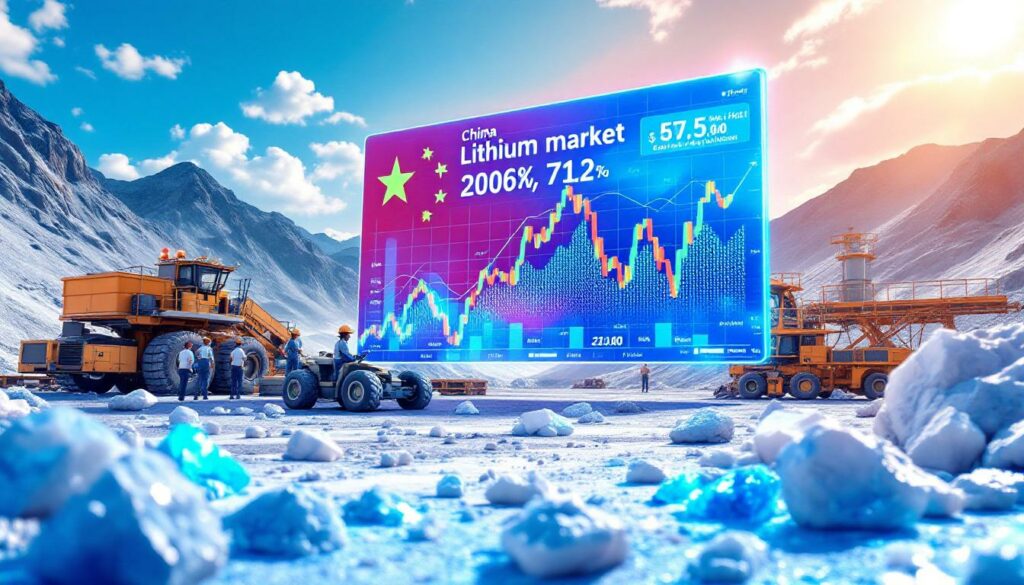What's Causing Recent Volatility in China's Lithium Markets?
China's lithium market has experienced dramatic price swings in recent months, capturing global attention and raising concerns about supply stability. These fluctuations have significant implications for the electric vehicle industry and energy storage sectors worldwide.
Price Fluctuations and Market Reactions
Chinese lithium carbonate futures surged an astonishing 14% in a single week during July 2025, including an 8% single-day limit increase on the Guangzhou Futures Exchange. This remarkable volatility prompted immediate regulatory intervention, with the exchange issuing notices to curb speculative trading that subsequently resulted in limit-down moves the following trading day.
The ripple effects quickly spread to equity markets, where lithium producer stocks experienced significant gains. Industry giants Tianqi Lithium and Chengxin Lithium Group both saw their shares rally approximately 25% in July 2025, reflecting heightened investor interest amid supply uncertainty.
Robin Tisserand of SCB Group attributed this volatility primarily to "speculative trading on market noise" rather than fundamental supply-demand shifts, highlighting how sentiment can dramatically impact commodity markets during periods of regulatory uncertainty.
Physical spodumene prices have also increased in response to the futures rally, creating cascading effects on international lithium contracts traded on platforms like CME Group. This interconnectedness demonstrates how Chinese market movements quickly translate to global price impacts.
Historical Price Context
To understand current market dynamics, it's essential to examine the dramatic price journey lithium has experienced in recent years. Lithium carbonate reached a record high of nearly 600,000 yuan ($84,000) per ton in 2022 during peak EV enthusiasm and supply constraints.
However, prices subsequently collapsed by a staggering 90% to approximately 60,000 yuan per ton in early 2025. This precipitous decline resulted from rapid capacity expansion creating oversupply conditions, coupled with slower-than-expected growth in EV battery demand as manufacturers faced economic headwinds.
This dramatic boom-bust cycle created market conditions ripe for supply-side adjustments, setting the stage for the government interventions we're witnessing today. The extreme price volatility has complicated long-term planning for both producers and consumers of lithium products.
How Are Government Actions Affecting Lithium Supply?
Chinese authorities have implemented a series of regulatory measures targeting lithium production, ostensibly to address issues ranging from environmental compliance to overcapacity concerns.
Regulatory Crackdown in Key Production Regions
Jiangxi province authorities have launched targeted inspections of eight lithium miners in Yichun, a region often referred to as China's "lithium capital" due to its concentrated resources. The Yichun Bureau of Natural Resources has mandated these operators submit comprehensive reserves reports by September 2025, creating immediate uncertainty about continued production authorization.
Government audits revealed widespread non-compliance issues in registration and approval processes, suggesting some operations may have expanded beyond their permitted scope. This regulatory scrutiny extends beyond Jiangxi, with Qinghai provincial authorities ordering Zangge Mining to halt operations entirely due to alleged illegal mining activities.
Cameron Perks of Benchmark Mineral Intelligence notes the significance of these actions, as Jiangxi province accounts for approximately 10% of global lithium production. While current volume impacts appear limited, the precedent established could signal broader enforcement actions.
Anti-Oversupply Measures
The Chinese government has initiated a comprehensive campaign against what it terms "involution" (excessive capacity) across various industrial sectors. This policy aims to eliminate unsustainable competition by restricting expansion in industries deemed to have excess capacity.
Lithium production has been specifically identified as a sector with potential overcapacity issues following the rapid expansion of mining and processing facilities during the 2021-2022 price boom. Jefferies analysts observe that these regulatory actions appear strategically timed following the significant price collapse in lithium markets.
The timing suggests a deliberate effort to stabilize prices through supply-side interventions rather than allowing market forces alone to determine production levels. This approach aligns with broader Chinese industrial policy that seeks to maintain strategic control over critical minerals energy transition.
What Production Disruptions Are Currently Occurring?
The regulatory environment has triggered both voluntary and mandated production suspensions across China's lithium sector, with several major producers announcing operational changes.
Voluntary and Mandated Production Suspensions
Jiangxi Special Electric Motor Co. announced a 26-day suspension of lithium salt production lines at its Yichun facility in July 2025. The company cited cost-cutting measures and maintenance requirements as justification, though market analysts have questioned whether regulatory pressure influenced this decision.
Similarly, Sinomine Resource Group halted a Jiangxi lithium project for six months to implement technological adjustments. The extended timeframe suggests substantial modifications to extraction or processing methods, potentially to address compliance issues or improve environmental performance.
More dramatically, Zangge Mining faced a government-mandated operational halt in Qinghai province following allegations of illegal mining activities. This forced closure underscores authorities' willingness to take decisive action against operators deemed non-compliant.
Supply Impact Assessment
While these disruptions create immediate market uncertainty, their volumetric impact remains somewhat limited in the context of global supply. Benchmark Mineral Intelligence estimates that Jiangxi province represents approximately 10% of global lithium production, with the affected operations constituting only a portion of the province's output.
The market's reaction appears disproportionate to current volume impacts, suggesting investors are pricing in the risk of more widespread disruptions. Analysts at Jefferies Financial Group note these actions create "expectations of strengthened inspections" that could significantly tighten market supply if enforcement becomes more stringent or widespread.
The psychological impact on market participants may ultimately prove more consequential than the immediate production losses, as uncertainty about future regulatory actions drives precautionary pricing behavior throughout the supply chain.
Why Is China's Lithium Market Important Globally?
China's outsized influence in global lithium markets stems from its dominant position across multiple segments of the supply chain, from mining to processing to battery manufacturing.
China's Dominance in the Lithium Supply Chain
China controls approximately 60% of global lithium processing capacity, giving it unprecedented influence over refined material availability. The country has rapidly expanded domestic lithium mining operations in regions like Jiangxi and Qinghai to reduce reliance on imported raw materials.
Chinese companies have simultaneously made substantial investments in international lithium assets, particularly in South America's "Lithium Triangle" (Chile, Argentina, Bolivia) and Australia. These strategic acquisitions ensure access to diverse supply sources while extending China's influence over global pricing.
Market movements in China directly impact global lithium pricing and availability due to this concentrated control over processing capacity. When Chinese domestic prices fluctuate, international contracts typically follow similar patterns with a short lag.
Strategic Implications for Battery Supply Chains
Lithium remains an irreplaceable component for electric vehicle batteries and energy storage systems, with few economically viable substitutes available at commercial scale. Supply disruptions in China could significantly impact global EV manufacturing targets as battery producers struggle to secure consistent material supply.
U.S. officials have previously accused China of "oversupplying lithium to eliminate rivals," though recent regulatory actions aimed at reducing oversupply appear to contradict this narrative. This shift highlights the complex geopolitical dynamics surrounding critical minerals essential for energy transition technologies.
Price volatility creates substantial challenges for battery manufacturers in forecasting costs and negotiating long-term supply agreements. With lithium representing approximately 20% of total battery costs, price swings directly impact EV affordability and manufacturer profitability.
Western nations have increasingly expressed concerns about overreliance on Chinese lithium supply chains, prompting efforts to develop alternative sources. However, China's first-mover advantage in processing infrastructure creates significant hurdles for supply diversification in the near term.
How Does This Affect the Global Lithium Market Outlook?
The recent volatility in Chinese lithium markets has significant implications for global supply-demand dynamics and investment patterns in the sector.
Market Sentiment and Investor Behavior
Recent price movements suggest investors anticipate potential supply constraints despite the previous oversupply condition. This sentiment shift highlights how quickly market fundamentals can change in response to regulatory interventions.
Speculative trading has amplified price volatility beyond what fundamental supply-demand factors would suggest, with futures contracts experiencing more dramatic moves than physical material prices. This disconnect creates challenges for producers and consumers attempting to hedge price exposure.
The market appears to be pricing in regulatory risk premiums for Chinese lithium operations, with higher valuations assigned to projects outside China that face fewer political uncertainties. This preference for geographical diversification represents a notable shift from previous investor behavior.
Producers outside China may benefit from higher prices if Chinese supply becomes constrained, potentially accelerating development timelines for projects in Australia, Canada, and the United States that previously struggled to compete with low-cost Chinese production.
Long-Term Supply-Demand Balance
Current disruptions could help rebalance a market that experienced significant oversupply following the 2021-2022 price boom. The 90% price decline from peak to trough created unsustainable conditions for many producers, necessitating either market exits or government intervention.
Reduced Chinese production might accelerate price recovery from 2025's low levels, providing financial relief to struggling producers while potentially raising input costs for battery manufacturers. This rebalancing could establish a more sustainable price corridor that supports continued investment in new supply.
Western lithium projects may receive increased attention and investment if Chinese supply appears less reliable or subject to unpredictable policy shifts. This could accelerate resource nationalism trends already emerging in North America and Europe.
The market remains susceptible to policy-driven supply adjustments rather than purely market-driven factors, making political risk assessment increasingly important for lithium investors. This regulatory uncertainty creates challenges for long-term capital allocation decisions throughout the battery supply chain.
What Are the Warning Signs of Further Supply Disruptions?
Monitoring specific indicators can help stakeholders anticipate additional supply constraints in China's lithium sector before they materialize.
Regulatory Red Flags to Monitor
Expanded mining inspections beyond currently identified operations would signal a broader campaign targeting the sector. Particular attention should focus on announcements from provincial natural resources bureaus in Jiangxi, Qinghai, and Sichuan.
New environmental compliance requirements for lithium extraction could force operational adjustments or temporary shutdowns, especially for leaching operations with higher water usage or tailings management challenges.
Production quotas or capacity restrictions implemented at provincial or national levels would represent a significant escalation of government intervention. Similar measures have previously been applied to other industrial sectors deemed to have overcapacity issues.
Additional permit reviews or suspensions in key lithium-producing regions would directly impact near-term supply availability. The September 2025 deadline for reserves reports in Jiangxi provides a critical checkpoint for assessing regulatory direction.
Industry Response Indicators
More companies announcing "voluntary" production suspensions would suggest widespread anticipation of stricter enforcement actions. These preemptive moves often indicate companies' assessment of regulatory risk based on non-public information.
Reduced capital expenditure plans for Chinese lithium projects would reflect diminished confidence in the regulatory environment. Quarterly financial reports from major producers like Tianqi and Ganfeng Lithium provide visibility into investment trends.
Shifts in lithium processing capacity to locations outside mainland China, particularly to Southeast Asia or established mining jurisdictions like Australia, would indicate strategic hedging against domestic regulatory risks.
Strategic stockpiling behavior by battery manufacturers or automakers would signal concerns about future availability, potentially accelerating price increases as precautionary inventory building adds to current demand.
How Might This Impact Electric Vehicle Production?
The lithium supply chain represents a critical vulnerability for the rapidly expanding electric vehicle industry, with potential disruptions threatening production targets and cost structures.
Battery Supply Chain Vulnerabilities
Lithium represents a critical input for EV battery production, accounting for approximately 20% of battery cell costs. Supply disruptions could create bottlenecks in battery manufacturing at a time when automakers are committing to ambitious electrification targets.
Price volatility complicates long-term supply agreements and cost projections, forcing battery manufacturers to either accept margin compression or pass costs to automakers. This uncertainty hampers strategic planning across the EV industry.
EV manufacturers with less diversified supply chains face greater exposure to Chinese market disruptions. Those relying heavily on Chinese battery suppliers or cells using Chinese-processed lithium may face greater production risks.
The timing is particularly challenging as global EV adoption accelerates, with annual growth projections of 25-30% through 2030 creating substantial incremental lithium demand that requires reliable supply expansion.
Potential Industry Adaptations
Accelerated development of lithium resources outside China represents the most direct response to supply concerns. Projects in Australia, Canada, and the United States may secure financing more easily as supply diversification becomes a strategic priority.
Increased interest in battery recycling to recover lithium from end-of-life batteries could reduce reliance on primary production. While currently small-scale, recycling capacity is expanding rapidly in Europe and North America.
Research into battery chemistries requiring less lithium has gained momentum, with sodium-ion and lithium-sulfur technologies receiving increased investment. However, these alternatives remain years away from mainstream commercial deployment.
More vertical integration by automakers into lithium supply chains could emerge as companies seek to secure critical materials. Tesla's discussions about direct investment in lithium mining exemplify this approach to supply security.
FAQ: China's Lithium Market Situation
What caused the recent spike in Chinese lithium prices?
Market speculation around potential supply disruptions following regulatory actions in key production regions, particularly Jiangxi province, drove prices up 14% in a single week in July 2025. This surge reflected investor concerns about possible production constraints rather than immediate supply shortages.
How much has China's lithium market changed since its peak?
Lithium carbonate prices in China have fallen approximately 90% from their 2022 peak of nearly 600,000 yuan to around 60,000 yuan in early 2025 before the recent uptick. This dramatic collapse resulted from rapid capacity expansion creating oversupply conditions that outpaced demand growth.
Which Chinese lithium producers are facing regulatory scrutiny?
Eight miners in Yichun (Jiangxi province) must submit reserves reports by September 2025, while Zangge Mining in Qinghai province has been ordered to halt operations due to alleged illegal mining activities. Jiangxi Special Electric Motor and Sinomine Resource Group have announced voluntary production suspensions.
What is China's "anti-involution" campaign?
It's a government initiative targeting industries with excessive production capacity, aiming to eliminate oversupply conditions that lead to unsustainable competition and market instability. The campaign seeks to rationalize industrial development by preventing unconstrained expansion that could undermine price stability and environmental standards.
How significant is Jiangxi province to global lithium supply?
According to Benchmark Mineral Intelligence, Jiangxi province accounts for approximately 10% of global lithium production, making it a significant contributor to worldwide supply. The region is particularly known for its lepidolite resources, which provide an alternative to the spodumene and brine operations more common elsewhere.
Further Exploration
Readers interested in learning more about developments in China's lithium markets can explore related educational content from industry specialists. MINING.com regularly covers global lithium market trends and supply chain developments, providing timely updates on regulatory changes and market movements.
Benchmark Mineral Intelligence offers detailed analysis of lithium price trends and production metrics for those seeking deeper quantitative insights into market dynamics. Their regional production data provides context for understanding the impact of localized disruptions.
Jefferies Financial Group publishes market commentary on regulatory impacts and investment opportunities within the lithium sector, offering perspective on how policy shifts might influence supply-demand balances and pricing trajectories.
These resources can help stakeholders navigate the complex interplay of market fundamentals, regulatory interventions, and geopolitical considerations shaping China's pivotal role in global lithium markets. Furthermore, those interested in international lithium developments might explore Australian lithium innovations or Argentine lithium opportunities as potential alternatives to Chinese supply. In North America, the Thacker Pass lithium mine represents a significant development, while Europe is advancing technologies for Italian geothermal extraction to diversify global supply chains.
Seeking to Profit from the Next Major Lithium Discovery?
Discovery Alert's proprietary Discovery IQ model delivers real-time notifications when significant mineral discoveries are announced on the ASX, turning complex data into actionable investment opportunities. Explore historic examples of exceptional returns from major discoveries by visiting the dedicated discoveries page and position yourself ahead of the market.




